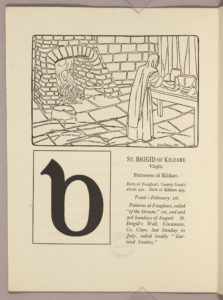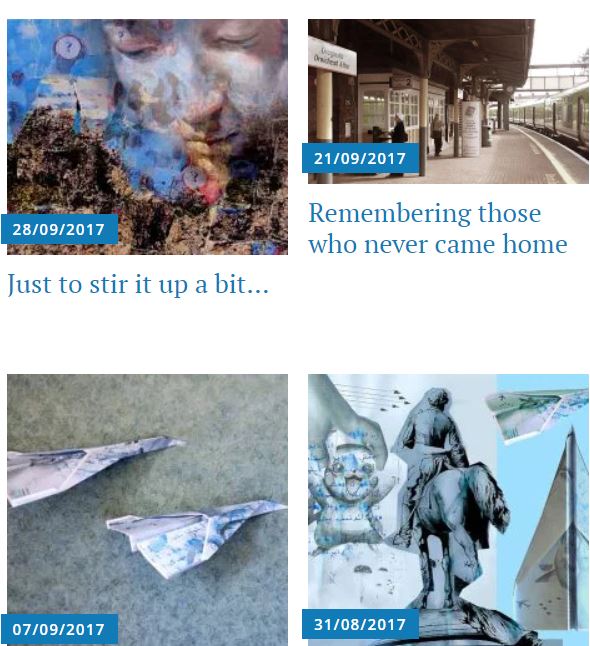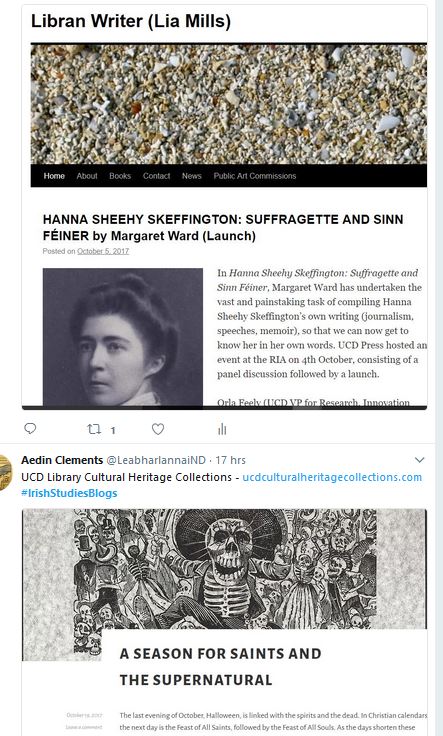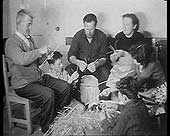Lá Fhéile Bríde and our Radharc Film collection
Posted on February 1, 2021 in Media, Old Books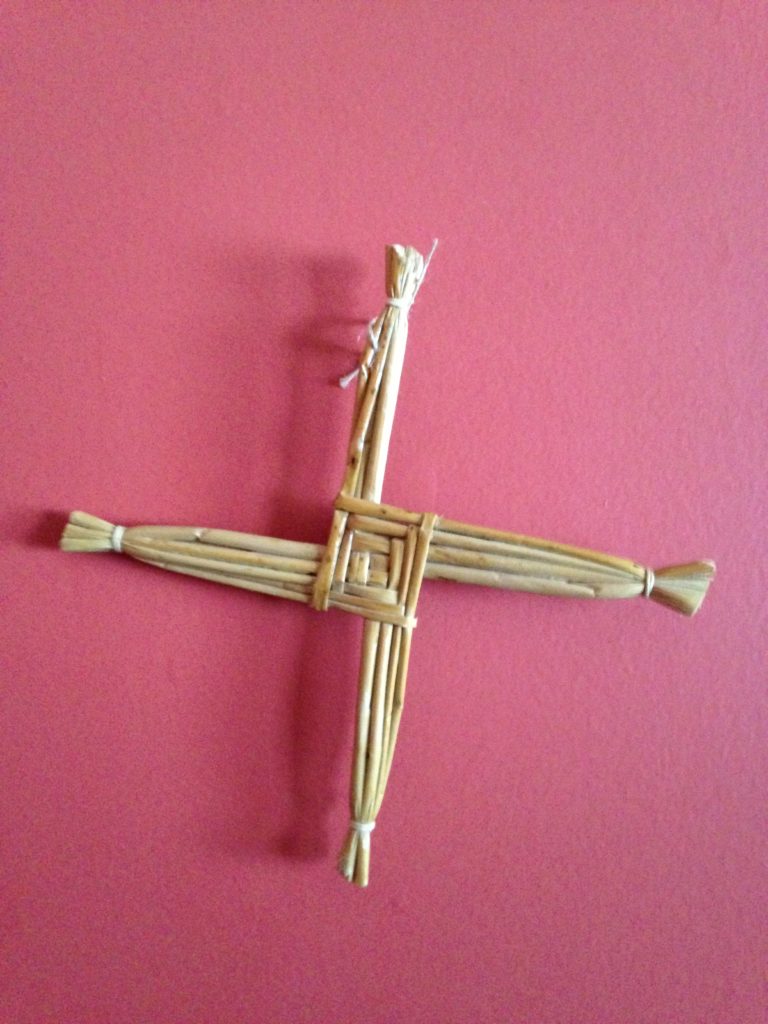
Mindful that this week’s Rare Books and Special Collections blogpost would go out on St. Brigid’s Day, we published a picture from an early twentieth-century children’s book, An Alphabet of Irish Saints.
This morning’s flurry of social media activity, including pictures and accounts of blankets and clothes put out overnight, and photographs of crosses like the cross above, reminds me of an inquiry we received a few years ago about our Radharc video collection.
Does anybody remember the Radharc films on RTÉ television? The Radharc Trust website provides a history, and some digital film and images may be found on websites of RTÉ and of the IFI.
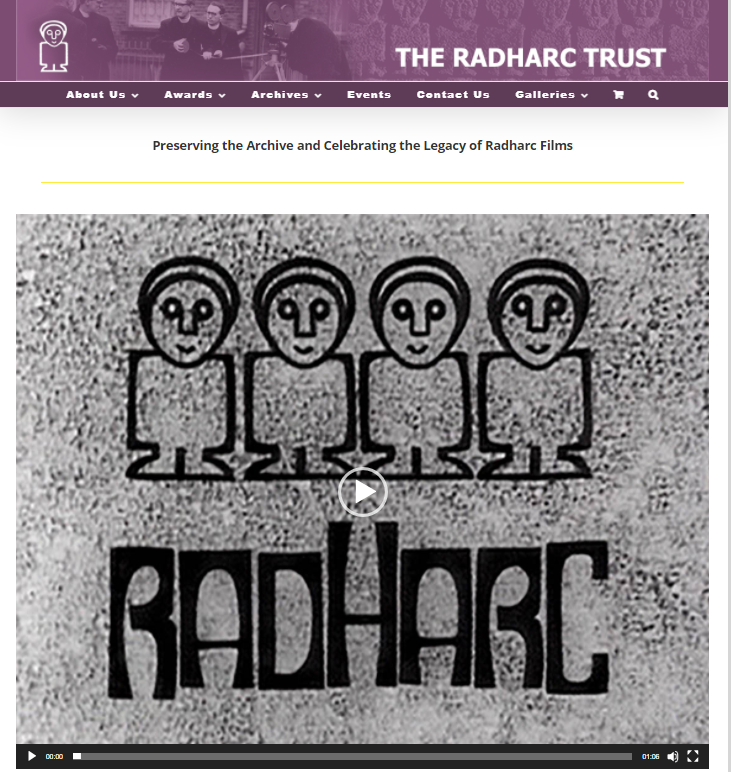
Among our DVDs of Radharc films is a very short documentary describing St. Brigid’s eve in a Co. Donegal household. Our correspondent who emailed from England turned out to be a member of the family featured in the film, and she was interested in obtaining a transcript. She added that her family had moved to Scotland, where the Edinburgh neighbors thought their annual observances of St. Brigid’s Day were quite unusual.
Now, as it happened, my colleague Gráinne Ní Mhuirí, who was a visiting Fulbright Irish language teacher, had used the film in her Irish class, and between us, we had transcribed the text and provided a rough translation, so we had the transcript on file.
The film begins with the Duffy men and boys outside, making preparations, while the women work indoors, and takes us through all the events of the eve of St. Brigid’s Day in the Duffy home.
I nGaeltacht Thír Chonaill tá mórán sean-nósanna in onóir Naoimh Bríd beo go fóill i measc na ndaoine.
Seo Anagaire, áit álainn os cionn na gCaslach, an áit a bhfuil teaghlach mhuintir Dhubhthaigh ina gcónaí.
Oíche Fhéile Bríde téid an seanduine agus Conal agus Liam amach fá choinne cochán a dheineas na crosa. Caithfear an cochán a thabhairt isteach roimh luí gréine. Scoitear agus glantar é mar mhínóis an seanduine do na stócaigh. In áiteanna I dTír Chonaill feaga is mó a bhíonn acu leis na crosa a dhéanamh ach measann siad in Anagaire gur fearr na crosa cocháin.
Istigh sa teach tá Bríd agus Bean Uí Dhubhthaigh ag cur síos tine leis na bruitíní a bhruith. Brúitíní, sin prátaí brúite agus bainne is im agus oinniúin is salann iontu. Beirtear na prátaí isteach ón pholl, caithfear a nglanadh go maith anocht, agus an pota a ghlanadh chomh maith.
Ní bhíonn bruitíní ag an teaghlach seo gach uile oíche – dhá oíche chionn féile sa bhliain a bhíos bruitíní acu, mar atá, Oíche Shamhna agus Oíche Fhéile Bhríde.
Bheir na fir lámh cuidithe leis an bhéile; baineann siad na súlógaí as na prátaí, ‘piocadh bruit]in’ an t-ainm a bheirtear ar an obair seo; nitear athuair as uisce glan iad agus tá siad réidh le cur ar an tine.
Agus oíche mar seo, fad is a bhíos na prátaí dá mbruth bheadh duine ag súil le scéal agus gheibhimid é. Insíonn an seanfhear ceann de na scéalta fá Naomh Bríd, scéalta a tháining aniar ón aimsir chianaosta ó ghlúin go glúin.
Níl sé chomh furasta pota prátaí a shileadh agus a shílfeadh duileadh aineolach, ach tá lámh maith ag mná Thír Chonaill air. Cuirtear crág shalainn agus oinniúin gearrtha ar na práta]I agus anois caithfear a brú. Tuirnín an t-ainm atá ar an maide a bhrúnns iad. Ní an tuirnís seo brúitín de na prátaí is righne dá …. bhealach.
Tuairim ar chearthrú I ndiaidh a haondéag, téann an teaghlach ar a nglúinibh le paidrín cúig ndeichniúr déag a rá. Le cois cionn a chur ar an Phaidrín, tá paidir ar leith acu an oíche seo, “Paidir agus Ave Máire le muid féin agus an méid is …. orainn a shábháil ar muir agus ar tír, ar tonn agus ar tráigh, gach bealach agus bearnas dá rachaimid. Agus go speisialta ar chaill agus ar urc.. na farraige móire.”
Paidir í seo atá ar fóirstin do dhaoine a chaithfeas a ngabháil I ngleic leis an fharraige mhóir ag saothrú a mbeatha nach bhfuil le fáil ar an talamh acu.
I dtráthaibh an mheán oíche, nuair atá an Paidrín ráite, tosaíonn Turas Bhríde, príomhócáid na féile. Bheir gach duine den teaghlach ball éadaigh do Bhríd, idir gheansaí nó stocaí, bheir Bríd léí na neadaí agus an p… chocháin agus téid sí amach ar an doras cúil. Téid sí thart far an teach thí huaire de thaobh na láimhe deise. Téid sí ar a glúine ag an doras tosaigh agus scairteann sí leis an teaghlach: “Gabhaigí ar bhur nglúine agus fosclaigí bhur súile agus ligigí isteach Bríd Bheannaithe.” Bheir siadsan freagra uirthi, “’Sé beatha, ‘sé beatha, ‘sé beatha na mná uaisle.” Coisrictear na héadaí le huisce coisricthe agus deirtear an urnaí, “Caithfidh mé seo in onóir Bhríde, le mo shábháin ar gach olc agus gach urchóid go bliain ó anocht.” Rud measartha deacair geansaí ag stócach le cur air.
Sa deireadh suíonn an teaghlach thart ag déanamh crosa Bhríde. Féachann gach duine le cros a dhéanamh, ach ar ndóigh tá daoine níos fearr ná daoine eile á ndéanamh.
Ní hionann a nitear crosa Bhríde i ngach … den tír. Anseo in Anagaire, ceanglaíonn siad dhá shlat dá chéile I bhfoirm croise agus fill siad na sipíní thart á cheangail. Is féidir gach rud go dtí fiche cros a dhéanamh ar an chros mhór amháin. Ansin cuirtear na crosa in airde sna creataí istigh sa teach agus sna bothaigh ag iarraidh coimirce Bhríde ar dhaoine agus ar ainmhithe sa bhliain atá romhainn. Fágtar na crosa sna háiteacha seo go bliain ó anocht. Coinnítear fuíollach an chocháin agus cuirtear I dtaisce é. Cuirtear deireadh leis an Fhéile le paidir, “Cuidiú Bríde go raibh fár mbun, agus fár mbarr in éadan gach olc agus gan urchóid go ceann bliana ón lá inniu.
In the Donegal Gaeltacht many traditions in honor of Saint Bridgid are still alive among the people.
This is Anagary, a beautiful place above Caslach, where the Duffy family live.
On the Eve of Brigid’s Day, the old people and conal and Liam go out to find straw to make the crosses. the straw must be brought in before sunset. The straw is separated and cleaned as the old people explain to the lads. In some places in Donegal, reeds are what they have for making the crosses, but the people in Anagary think the straw crosses are better.
In the house, Bríd and Mrs. Duffy are setting the fire to boil the brúitín. Brúitíní, that is, potatoes mashed with milk and butter and onion and salt.
The potatoes are brought in from the hole; they must be well-washed tonight, and the pot must also be washed.
This family does not have brúitín every night. Two nights of the eve of a festival annually is when they have brúitín, that is, Halloween and St. Brigid’s Night.
The men give a helping had with the meal; they remove the eyes from the potatoes. “Piocadh brúitín” is what this work is called. They are washed once more in clean water, and then they are ready to be placed on the fire.
And a night like this, as the potatoes are being boiled, one would expect a story, and we have it. The old man tells one of the stories about Saint Bridgit, stories that came from the old days, passed from generation to generation.
It’s not as easy to prepare a pot of potatoes as one might think , but the women of Donegal are practised at it. Salt and chopped onion are added to the potatoes and now it must be mashed. The utensil with which they are mashed is called a Tuirnín. ….
At about a quarter past eleven, the family go on their knees to say five decades of the Rosary. At the head of the Rosary, they have a special prayer for this night, “A Prayer and Ave Maria to keep ourselves and … safe on land and sea, on wave and beach, every way and place where we go. And especially …. on the great sea.
This is a prayer that helps people who must to to sea to make their living as there is not sufficient for them on land.
About midnight, when the Rosary has been said, the Turas Bhríde (Bridgid’s Tour) begins, the main event of the festival. Every member of the family holds a piece of Bridgid’s clothing, either geansaí (sweater) or socks, and Bridgid lods the … and the straw bundle, and she goes out the back door. She goes three times around the house on her right (clockwise). She goes on her knees at the front door and she calls to the family: “Go on your knees and open your eyes and let Holy Bridgid in.” They reply, “’Sé beatha (Hail), ‘sé beatha, ‘sé beatha gentlewoman.” The clothes are blessed with holy water and the prayer is recited, “I will wear this in honor of Bridgid, to protect me from every harm and every iniquity for a year from tonight.”
It is quite difficult to put a geansaí on a young boy.
At last the family sit around making the St. Bridgid’s Crosses. Each person likes to make a cross, but of course some people are better than others at making them.
St. Bridgid’s Crosses are not the same all over the country. Here in Anagary, they tie two sticks together in the form of a cross, and they fold the together in the form of a cross and fold the twigs around to tie them. Up to twenty crosses can be made on one big cross.
Then the crosses are put up in the rafters in the house and in the sheds to ask for Bridgid’s protection for the people and animals in the year ahead. The crosses are left in this place for a year from tonight.
The remaining straw is kept and put away. The festival ends with the prayer, “May the help of Bridgid be below and above, against every ill and every iniquity for a year from today.
The film is found in our catalog as Bridgid’s Night, with the information that it was filmed in Co. Donegal in 1961.
To learn more about our video collections, see our library guide to Ireland on Film.






